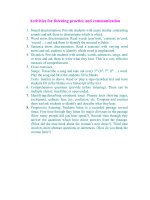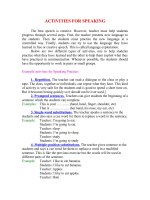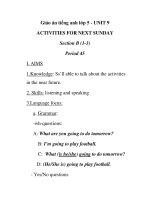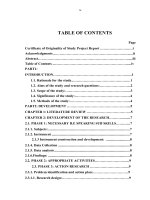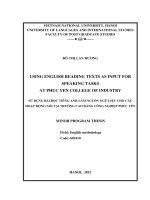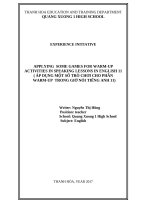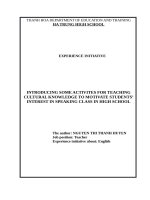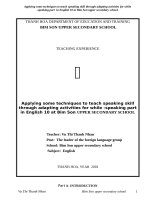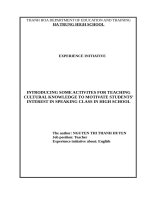ACTIVITIES FOR SPEAKING.doc
Bạn đang xem bản rút gọn của tài liệu. Xem và tải ngay bản đầy đủ của tài liệu tại đây (59.61 KB, 2 trang )
ACTIVITIES FOR SPEAKING
The best speech is creative. However, teacher must help students
progress through several steps. First, the teacher presents new language to
the students. Then the students must practice the new language in a
controlled way. Finally, students can try to use the language they have
learned in free or creative speech. This is called language exploitation.
Below are two different types of activities, one to help students
practice what they have learned and the other to help them exploit what they
have practiced in communication. Whenever possible, the students should
have the opportunity to work in pairs or small groups.
Example activities for Speaking Practice:
1. Repetition. The teacher can read a dialogue to the class or play a
tape. The class, together or individuals, can repeat what they hear. This kind
of activity is very safe for the students and is good to spend a short time on.
But it becomes boring quickly so it should not be over used.]
2. Prompted sentences. Teachers can give students the beginning of a
sentence which the students can complete.
Examples: This is your ……….. (hand, head, finger, shoulder, etc)
That is …………….. (her hand, his nose, my ear, etc)
3. Single-word substitutions. The teacher speaks a sentence to the
students and also says a cue word for them to replace a word in the sentence.
Example: Teacher: I’m going to eat.
Students: I’m going to eat.
Teacher: sleep
Students: I’m going to sleep.
Teacher: study
Students: I’m going to study
4. Multiple-position substitutions. The teacher gives sentence to the
students and says a cue word for them to replace a word in a modified
sentence. This is like the previous exercise but the words will be used in
different parts of the sentence.
Example: Teacher: I like to eat bananas.
Students: I like to eat bananas.
Teacher: Apples
Students: I like to eat apples.
Teacher: Hate
Students: I hate to eat apples.
Teacher: John
Students: John hates to eat apples.
..etc.
5. Transformation Exercises. The teacher gives a sentence to
students along in a brief instruction which forces the students to
communicate with other form.
Example: Teacher: I study English.
Students: I study English.
Teacher: Yesterday.
Students: I studied English yesterday.
Teacher: Tomorrow.
Students: I will study English tomorrow.
Teacher: Now
Students: I am studying English now.
6. Chaining. In this kind of exercise, students are given a simple
dialogue in which they practice a given pattern.
Example: Minh:Hi. I’m Minh
Mai: Hello. Minh. I’m Mai.
Nam: Hello, Mai. I’m Nam.
7. Dialogue practice. In a dialogue, there are usually two or three
speakers. After presenting the dialogue to the class, the teacher assigns
different students to speak the different pans. After the students have
practiced and understood the dialogue, they can practice again, using
information of their own.
8. Dialogue creation. Students can be, given the beginning lines in a
dialogue and instructed to finish the dialogue creatively.
9. Songs. Students can study and learn to sing songs to practice their
speaking.
10. Tongue Twisters and Other Pronunciation Exercises.
(Sưu tầm)
